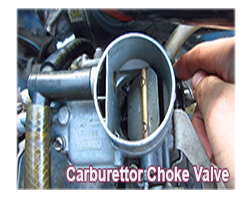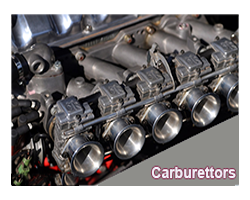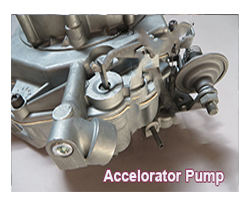
CARBURETTOR: Describes the device that vapourises fuel and mixes it with air in proper quantities and proportions to suit the engine's varying needs.
Describes the device that vapourises fuel and mixes it with air in proper quantities and proportions to suit the engine's varying needs.
ACCELERATOR: Describes a pedal attached by linkage to the throttle in the carburettor that regulates the amount of fuel sent to the engine
ACCELERATOR PUMP: Describes: the small pump usually located inside the carburettor that sprays an extra amount of fuel into the engine during acceleration, providing increased boost and reducing any momentary lags in power.
ADAPTER CARBURETTOR: Describes a type of device attached to a gasoline carburettor that permits an internal combustion engine to run either on gas or liquefied petroleum gas (LP gas).
ADJUSTABLE PART THROTTLE (APT): Describes a supplementary circuit found on some carburettors that can be adjusted to control part-throttle mixtures more accurately than a fixed orifice through detouring around the main jet to the discharge nozzle feed well.
BELL MOUTH: Describes the bell-shaped air intake attached to some carburettors.
CARBURETTOR ADAPTER: Describes an adapter used to fit or place one type of carburettor on an intake manifold that may not be initially designed for it.
CARBURETTOR BARREL: Describes the tube-like part of the vehicle through which air flows and is mixed with vapourised fuel.
CARBURETTOR CIRCUIT: Describes the series of passageways and units designed to perform a specific function idle circuit or a complete power circuit.
CARBURETOR FLOAT: Describes a small hollow tank whose characteristics make it more buoyant than the liquid in which it is immersed. In a carburettor, the float operates the valve (needle and seat), controlling the fuel level entering the carburettor while in the fuel tank, it indicates the amount of fuel.
CHOKE: Describes a butterfly valve or plate near the top of the carburettor that limits or restricts the amount of air allowed to enter the carburettor, thus enriching the fuel-air mixture enabling the vehicle to start and run more efficiently when cold. Automatic chokes have a thermostatic coil or thermostatic spring that activates a butterfly valve at the top of the carburettor barrel. Older cars have manually operated chokes.
CHOKE CONTROL: Describes a device or system for operating a non-automatic choke, usually comprising a cable attached at one end to the choke butterfly and a knob on the dash at the other end.
COMPENSATING JET:  Describes a fuel tube or pipe in the carburettor, where air is admitted through one or more holes to compensate for the primary nozzle's tendency to deliver a rich mixture as air velocity through the carburettor increases.
Describes a fuel tube or pipe in the carburettor, where air is admitted through one or more holes to compensate for the primary nozzle's tendency to deliver a rich mixture as air velocity through the carburettor increases.


